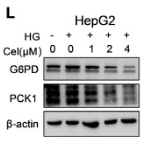G6PC Antibody - #DF12610
| Product: | G6PC Antibody |
| Catalog: | DF12610 |
| Description: | Rabbit polyclonal antibody to G6PC |
| Application: | WB |
| Cited expt.: | WB |
| Reactivity: | Human |
| Prediction: | Bovine, Horse, Sheep, Rabbit, Dog, Chicken |
| Mol.Wt.: | 40 kDa; 40kD(Calculated). |
| Uniprot: | P35575 |
| RRID: | AB_2845572 |
Related Downloads
Protocols
Product Info
*The optimal dilutions should be determined by the end user. For optimal experimental results, antibody reuse is not recommended.
*Tips:
WB: For western blot detection of denatured protein samples. IHC: For immunohistochemical detection of paraffin sections (IHC-p) or frozen sections (IHC-f) of tissue samples. IF/ICC: For immunofluorescence detection of cell samples. ELISA(peptide): For ELISA detection of antigenic peptide.
Cite Format: Affinity Biosciences Cat# DF12610, RRID:AB_2845572.
Fold/Unfold
AW107337; G-6-Pase; G6Pase; G6Pase-alpha; g6pc; G6PC_HUMAN; G6PT; Glucose-6-phosphatase alpha; Glucose-6-phosphatase; glucose-6-phosphatase, catalytic subunit; GSD1; GSD1a; MGC163350; MGC93613; RP23-281C18.19;
Immunogens
A synthesized peptide derived from human G6PC, corresponding to a region within the internal amino acids.
- P35575 G6PC_HUMAN:
- Protein BLAST With
- NCBI/
- ExPASy/
- Uniprot
MEEGMNVLHDFGIQSTHYLQVNYQDSQDWFILVSVIADLRNAFYVLFPIWFHLQEAVGIKLLWVAVIGDWLNLVFKWILFGQRPYWWVLDTDYYSNTSVPLIKQFPVTCETGPGSPSGHAMGTAGVYYVMVTSTLSIFQGKIKPTYRFRCLNVILWLGFWAVQLNVCLSRIYLAAHFPHQVVAGVLSGIAVAETFSHIHSIYNASLKKYFLITFFLFSFAIGFYLLLKGLGVDLLWTLEKAQRWCEQPEWVHIDTTPFASLLKNLGTLFGLGLALNSSMYRESCKGKLSKWLPFRLSSIVASLVLLHVFDSLKPPSQVELVFYVLSFCKSAVVPLASVSVIPYCLAQVLGQPHKKSL
Predictions
Score>80(red) has high confidence and is suggested to be used for WB detection. *The prediction model is mainly based on the alignment of immunogen sequences, the results are for reference only, not as the basis of quality assurance.
High(score>80) Medium(80>score>50) Low(score<50) No confidence
Research Backgrounds
Hydrolyzes glucose-6-phosphate to glucose in the endoplasmic reticulum. Forms with the glucose-6-phosphate transporter (SLC37A4/G6PT) the complex responsible for glucose production through glycogenolysis and gluconeogenesis. Hence, it is the key enzyme in homeostatic regulation of blood glucose levels.
Endoplasmic reticulum membrane>Multi-pass membrane protein.
Belongs to the glucose-6-phosphatase family.
Research Fields
· Environmental Information Processing > Signal transduction > FoxO signaling pathway. (View pathway)
· Environmental Information Processing > Signal transduction > PI3K-Akt signaling pathway. (View pathway)
· Environmental Information Processing > Signal transduction > AMPK signaling pathway. (View pathway)
· Human Diseases > Endocrine and metabolic diseases > Insulin resistance.
· Metabolism > Carbohydrate metabolism > Glycolysis / Gluconeogenesis.
· Metabolism > Carbohydrate metabolism > Galactose metabolism.
· Metabolism > Carbohydrate metabolism > Starch and sucrose metabolism.
· Metabolism > Global and overview maps > Metabolic pathways.
· Organismal Systems > Endocrine system > Insulin signaling pathway. (View pathway)
· Organismal Systems > Endocrine system > Adipocytokine signaling pathway.
· Organismal Systems > Endocrine system > Glucagon signaling pathway.
· Organismal Systems > Digestive system > Carbohydrate digestion and absorption.
References
Application: WB Species: Mouse Sample:
Restrictive clause
Affinity Biosciences tests all products strictly. Citations are provided as a resource for additional applications that have not been validated by Affinity Biosciences. Please choose the appropriate format for each application and consult Materials and Methods sections for additional details about the use of any product in these publications.
For Research Use Only.
Not for use in diagnostic or therapeutic procedures. Not for resale. Not for distribution without written consent. Affinity Biosciences will not be held responsible for patent infringement or other violations that may occur with the use of our products. Affinity Biosciences, Affinity Biosciences Logo and all other trademarks are the property of Affinity Biosciences LTD.

